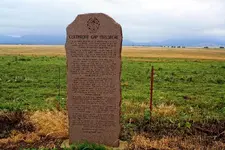RGINN
Gold Member
- Joined
- Oct 16, 2007
- Messages
- 8,948
- Reaction score
- 12,269
- Golden Thread
- 0
- Location
- Summit County, CO
- 🏆 Honorable Mentions:
- 1
- Detector(s) used
- White's DFX, White's Classic 1 Coinmaster, Nokta Pointer
- Primary Interest:
- All Treasure Hunting
- #1
Thread Owner
Since we're still snowed in I can't do much but read about treasure and research, so I'll share my info on a legend that is actually a fact. As usual, anything connected to treasure invites conjecture and argument, but I'll present the basics of the best info I have, and cite my sources. In December of 1832 a party of American traders, led by Judge W. C. Carr, were travelling from Santa Fe across the Texas Panhandle heading to Missouri. They were travelling along the South Canadian River (source says near present Lathrop, TX, but I can't find that town) when they were attacked by a group of Kiowas. After a long seige with two killed, the rest of the traders made their escape, leaving behind their gear and a large amount of Mexican silver money, maybe about $10,000 worth. The Kiowas took the stuff and some of the silver coins, which they beat into ornaments. Later on, some Comanches told them that was the white man's money, so the Kiowas returned to the battle site and dug around in the sand, and found a bunch more coins. The Set-tan tribal history calendar pictograph for winter, 1832-33, notes this event with a symbol for Black Wolf who was killed in the fight, and a coin with an eagle on it. In the late spring of 1833 the entire Kiowa tribe was camped near the mouth of Rainy Mountain Creek near present day Mt. View, OK. They had a brief scare when they found evidence of Osage raiders in the area, but everything calmed down after a few days. A large party of almost all the fighting men took off the fight the Utes, and the remainder of the group split up. One group, led by Ah-da-te, principal chief at the time headed southeast to Eagle Heart Springs, near the head of Cache Creek. After a couple of days, they headed over west to Saddle Mountain Creek, about a half mile from the present Saddle Mountain store. They moved once more to the west, through Cutthroat Gap, and set up camp there.




